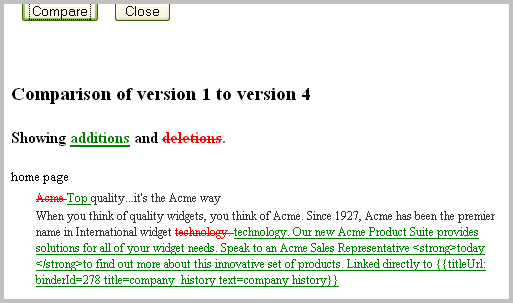3.2 Folder Types
Folder types define the type of activities that you do within a folder and how you do them. So, folder types can actually be thought of as applications, where each different type of folder functions as a separate “program” within Novell Teaming.
Most of the folder tools are common across all types of folders. Examples include most of the tools in the tools sidebar, accessories, subscriptions, team features, sorting, folder views, filtering, and basic folder-page navigation. The subsections that follow are ordered alphabetically and indicate some significant differences in the way a particular folder type functions.
This section contains the following subsections:
3.2.1 Blogs
Blogs are chronologically listed journal entries. Blog entries resemble discussion-list entries:
Figure 3-37 A Blog Entry
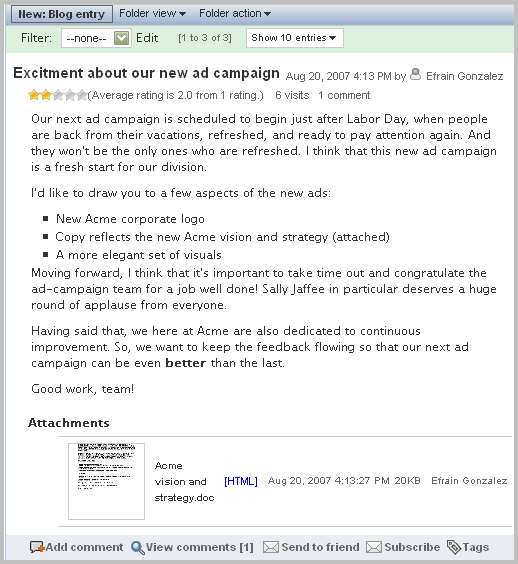
When you first view a blog folder, Novell Teaming displays all entries, from the most recently authored to the oldest (reverse chronological order).
For blog folders, the tools sidebar includes a Blog section that you can use to filter the display of blog entries:
Figure 3-38 The Calendar and Archive Tools for a Blog
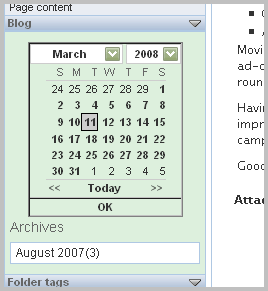
The Blog section of the tools sidebar in the previous picture includes a calendar tool and an section.
The calendar tool allows you to begin the list of journal entries at a specific date. To specify a date, use the drop-down lists to select a month and year, and click the number of a day. After you specify a date, Novell Teaming lists all blog entries authored on or before the date, in reverse chronological order, with the entry authored closest to the specified date appearing as the first entry in the list. To return to the default list, click , located toward the bottom of the calendar tool.
The section displays the linked names of months followed by the number of journal entries authored in those months. When you click the name of a month, Novell Teaming displays only that month’s journal entries in reverse chronological order. To return to the default blog-folder display, click in the calendar tool. If you want to begin the list of journal entries at a date already displaying in the calendar, click in the calendar tool.
In Figure 3-38, none of the entries in the blog folder are tagged (see Section 3.1.3, Tags). If one or more entries are tagged, then Novell Teaming places lists of the Personal and Community tags just below the section. In those sections, click on a linked tag name to view in reverse chronological order only those blog entries tagged with that name. Again, to return to the default blog-folder display, click in the calendar tool.
3.2.2 Discussions
Discussion folders allow you to post entries and make comments about those entries. Previous topics in this document have described discussion folders, and shown pictures of their tools and pages (see Section 1.3.3, Viewing a Workspace or Folder).
By default, if you choose, there are two views that are designed for use with discussion folders. A view is a page design used to display information (in this case, information about entries and comments in a discussion folder). For example, if you changed the view from its default of “list” to “table,” then this is how the discussion folder appears:
Figure 3-39 The Table View of a Discussion Folder
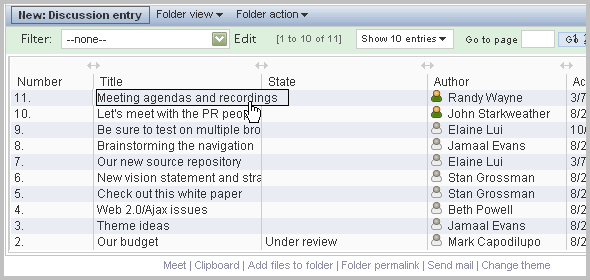
Titles of entries that have not yet been viewed are bold. Hover your mouse over a title, and Novell Teaming displays the full text of that title. Click, hold, and drag one of the double-arrow icons that are located above the horizontal lines in the table, and you can expand and collapse the width of the column. Click a column header (, , , , ), and Novell Teaming sorts the table by the values in that column.
3.2.3 Calendars
Calendars help you to keep track of time-ordered appointments or events. By default, a calendar folder displays a monthly view of events:
Figure 3-40 A Calendar Page

The menu bar contains a tool to import calendars:
Figure 3-41 The Import Calendar Link
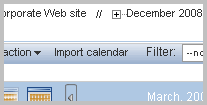
Most of the unique calendar tools appear under the menu bar:
Figure 3-42 Calendar Tools

The tool used to export Novell Teaming calendar data is located in the footer tools:
Figure 3-43 The iCal Link

The following are some of the unique calendar tools:
-
Import calendar: Allows you to import calendar entries in iCal format (for example, entries from Google and Outlook*).
-
Show entries by: Changes the criteria used to place the event on the calendar from the default, which is the event date. This feature is most useful when viewing non-calendar information in a calendar view. For example, by default, you can view discussion entries in a calendar view, and then you can use this feature to show entries according to creation or the last activity date.
-
Work day: Allows you to define a day as being a work day (defined by your site administrator) or as a full calendar day, which includes non-work days, such as weekend days.
-
Number of days (calendar pages): Changes the number of days shown on a calendar folder page (the default is one month, thirty days).
-
Previous and next page (arrows): Displays the previous set and next set of days. For example, if the calendar is currently displaying a month, these icons display the previous and next month of entries.
-
Calendar applet: The square icon to the right of the next-page icon displays a panel showing the current month, which you can use to navigate to specific months or days.
-
iCal link: This link allows you to export calendar entries in iCal format.
3.2.4 Guestbooks
Guestbooks are folders that allow visitors to sign in and announce their presence on a page. By default, personal workspaces contain guestbooks and accessories that show a summary of the guestbook entries. Given our sample installation, the guestbook shown in the following graphic is located in someone’s personal workspace:
Figure 3-44 A Guestbook Folder
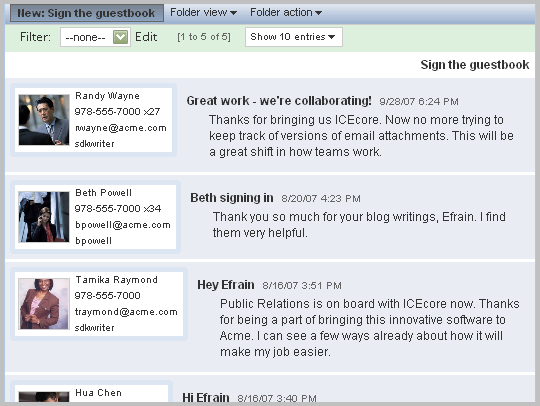
3.2.5 File Folders
File folders contain an alphabetized list of files in a table format. The table functions the same as the table view described in the discussion-folders section (see Section 3.2.2, Discussions). Consider the following:
Figure 3-45 A Folder File
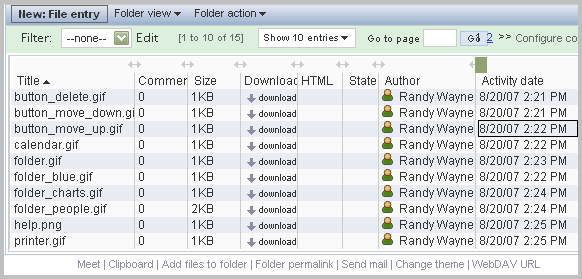
3.2.6 Milestone Folders
A milestone folder tracks the progress of several task folders. Although you can use milestone folders outside of the scope of a project workspace, they are most often used in those workspaces. See Section 3.3.4, Project Workspaces for more information.
3.2.7 Photo Albums
Photo albums display pictures. The sample installation includes a set of humorous pictures placed in a photo album in the area:
Figure 3-46 A Photo Album
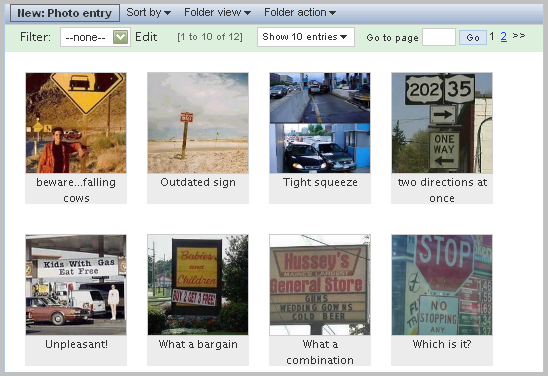
When you click a thumbnail picture, Novell Teaming displays the full-sized photo in a separate window:
Figure 3-47 Viewing a Picture in a Photo Album
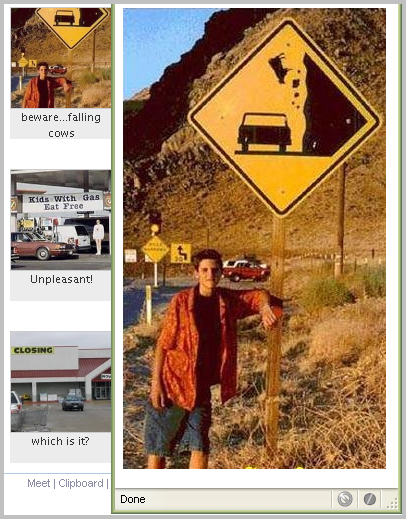
3.2.8 Surveys
Survey folders present polling questions to teammates. To participate in a survey, view the survey folder, and click the entry title of a survey. Next, provide answers to questions, and click .
Given our sample installation, Marcelo Hernandes, Acme Events Manager, wants to poll his organization regarding which trade shows should be priorities for his organization. The survey is composed of the three different types of questions available using Novell Teaming surveys: a multiple-answer question, a single-answer question, and a write-in-response question.
In our sample installation, the first question allows you to specify more than one answer:
Figure 3-48 Providing More Than One Answer to a Survey Question
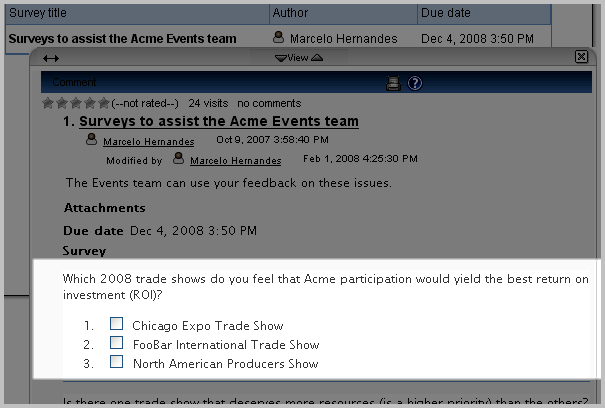
The second question accepts only a single answer:
Figure 3-49 A Question That Accepts Only a Single Answer

The third question requests a write-in response:
Figure 3-50 Providing a Write-In Answer to a Question

After you have voted, you can check the results by viewing the entry again. This is an example of how people have voted so far in response to the first question:
Figure 3-51 Survey Results for the First Question
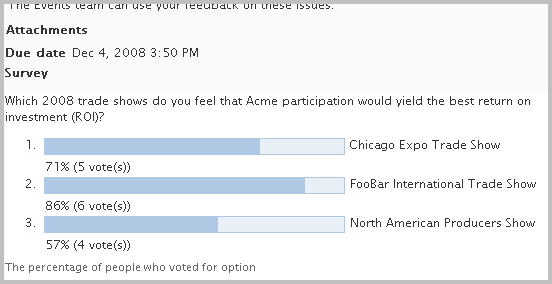
3.2.9 Tasks
A task folder keeps track of the progress made in completing work assignments. Although you can use task folders outside of the scope of a project workspace, they are most often used in those workspaces (see Section 3.3.4, Project Workspaces).
3.2.10 Wikis
Wikis are folders whose entries are coauthored by all participants in the folder. Wiki folders have additional tools in the tools sidebar:
Figure 3-52 Wiki Navigation Tools
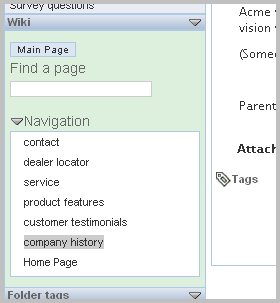
Use the type-to-find feature in the text box. The section lists all of the pages in the wiki folder. The standard folder tool, , determines how many page titles are listed here by default. If there are more pages, then Novell Teaming displays a right-arrow icon in the bottom right corner of the box that allows you to move through lists of all the pages in the wiki folder.
By default, Novell Teaming does not display an entry when you first view a wiki folder. If you want an entry to display when someone first views the folder, click the link:
Figure 3-53 Setting the Main Page of a Wiki Folder
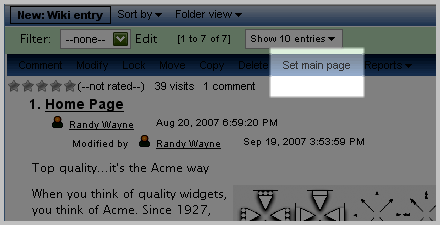
NOTE:When you create a wiki folder, be sure to configure the folder so that all entry titles must be unique.
When working with a wiki entry, it can be helpful to review edits that your teammates might have made to it. To review edits, view a wiki page, and click > :
Figure 3-54 The Edit History Menu Item
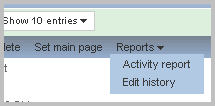
Novell Teaming displays a new browser window. In that window, select the edit versions that you want to review, and click . This graphic indicates that you want to compare version 1 of the document (as indicated by the selected radio button in the first column) with its fourth version (as indicated by the selected radio button in the second column):
Figure 3-55 The Edit History Form
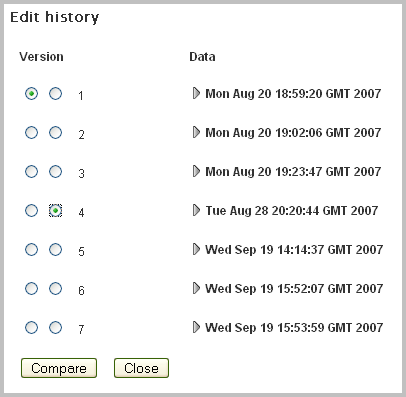
Novell Teaming displays a version of the entry that indicates additions and deletions between the two versions, and displays that information at the bottom of the window:
Figure 3-56 Comparing Two Different Versions of a Wiki Entry
